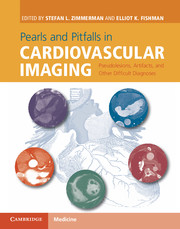 Pearls and Pitfalls in Cardiovascular Imaging
Pearls and Pitfalls in Cardiovascular Imaging from Section 10 - Peripheral vascular
Published online by Cambridge University Press: 05 June 2015
Imaging description
Multidetector computed tomographic angiography (CTA) is a fast non-invasive imaging technique with a sensitivity of 95% and a specificity of 99% for detection of arterial injuries in the extremities. CTA is usually performed with 100–120ml of contrast material injected at a rate of 4ml/sec and images acquired at the time of maximal arterial enhancement (around 40 seconds). Bolus tracking may be used but is usually not necessary as most of the patients in the trauma setting are young adults. Evaluation is performed with axial images along with sagittal and coronal reconstructions and three-dimensional post-processing techniques such as volume rendering and MIP. In the presence of an arteriovenous fistula (AVF) there is early filling of the involved vein on arterial phase imaging and lack of contrast opacification of the veins on the contralateral side (Figures 88.1 and 88.2).
Importance
AVFs are due to abnormal connections between the arterial and venous system bypassing the normal capillary beds. Acquired AVF usually occurs as a consequence of percutaneous vascular access but can also be secondary to penetrating injury to the lower extremity from stab wounds and gunshot injuries. Accurate diagnosis is important as long-standing AVFs can cause edema, arterial aneurysm, ischemia, and even high-output cardiac failure. There is excellent prognosis of AVFs after surgical or endovascular repair.
Typical clinical scenario
Typically presentation would be a young person with history of lower extremity penetrating trauma presenting with limb edema. On examination machine-like murmur, bruit, or a pulsatile mass may be found.
Differential diagnosis
Inaccurate or mistiming of the bolus may cause opacification of the veins interfering with the evaluation of AVF. Absence of opacification of the contralateral veins helps differentiate mistiming of contrast bolus from an AVF. Intravenous contrast injection from the lower extremity causes opacification of the ipsilateral venous system; however, the contrast is usually denser than within the arteries (Figure 88.2). In the presence of central venous obstruction, early opacification of a peripheral vein can also occur due to the presence of collateral vessels (Figure 88.3).
To save this book to your Kindle, first ensure [email protected] is added to your Approved Personal Document E-mail List under your Personal Document Settings on the Manage Your Content and Devices page of your Amazon account. Then enter the ‘name’ part of your Kindle email address below. Find out more about saving to your Kindle.
Note you can select to save to either the @free.kindle.com or @kindle.com variations. ‘@free.kindle.com’ emails are free but can only be saved to your device when it is connected to wi-fi. ‘@kindle.com’ emails can be delivered even when you are not connected to wi-fi, but note that service fees apply.
Find out more about the Kindle Personal Document Service.
To save content items to your account, please confirm that you agree to abide by our usage policies. If this is the first time you use this feature, you will be asked to authorise Cambridge Core to connect with your account. Find out more about saving content to Dropbox.
To save content items to your account, please confirm that you agree to abide by our usage policies. If this is the first time you use this feature, you will be asked to authorise Cambridge Core to connect with your account. Find out more about saving content to Google Drive.